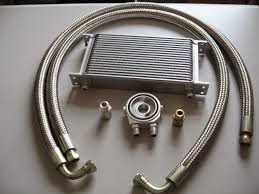The term oil cooler and oil cooling became very popular in India after launching the Pulsar series 200 (discontinued) and 220 F from Bajaj motors. Oil cooling as we know from the name itself is cooling of engine oil by help of a special component called an oil cooler. Generally an engine oil will loose its viscosity if temperatures are very high than its specified heat range. As a result it may not be able to lubricate the mechanical components properly as specified. To overcome this problem and to provide better cooling especially for air cooled high performance engines oil coolers are generally used.
Oil cooling is a way apart from liquid cooling mainly in the following aspects,
* It does not maintain a constant temperature like a liquid cooled engine.
* It does not have a thermostat, bypass system and cooling fan but instead uses a small radiator alone.
* Cost wise it is very economical because of simplicity and components involved.
So lets see how it works,
 |
| Engine oil lubrication circuit in Karizma ZMR |
The oil pump which is normally used in a conventional engine pumps and circulates oil for lubrication (forced lubrication) to all parts in a particular circuit. It starts from the crankcase and ends back in the crankcase after lubrication.
Where as in oil cooling it reaches a radiator fixed outside from a centrifugal filter, cooled and then circulated back to the engine.
CONS,
As already told it cannot maintain a steady engine temperature like liquid cooling. The oil flow to radiator is not controlled by any thermostat like a coolant controlled by a liquid cooled engine and engine oil begins to flow to the radiator as soon as the engine is fired up.
During heavy start, stop traffic and idling where there is minimal airflow this system loses its potential but it provides better cooling when there is a steady air flow while riding and in long run.
Hence a liquid cooled engine offers better engine cooling and performance than an air cooled engine. This can also improve the life of engine oil as well.
 |
| Horizontally placed radiator in Pulsar 220 F |
 |
| Vertically positioned oil cooler in Karizma ZMR engine |
The oil cooling system after being used in pulsar 220 is adapted with minor changes to Hero Karizma ZMR by placing the radiator vertically, which is proved to be a better design than Pulsar's horizontally mounted one.
In cars oil coolers are sometimes used mainly on cars equipped with automatic transmission to cool automatic transmission fluid (ATF). Apart from that, by default many cars don't use an oil cooler unless its customized for racing.
 |
| Oil cooler in a car |

On the whole its a cost effective way to improve cooling system especially for an air cooled engine.


